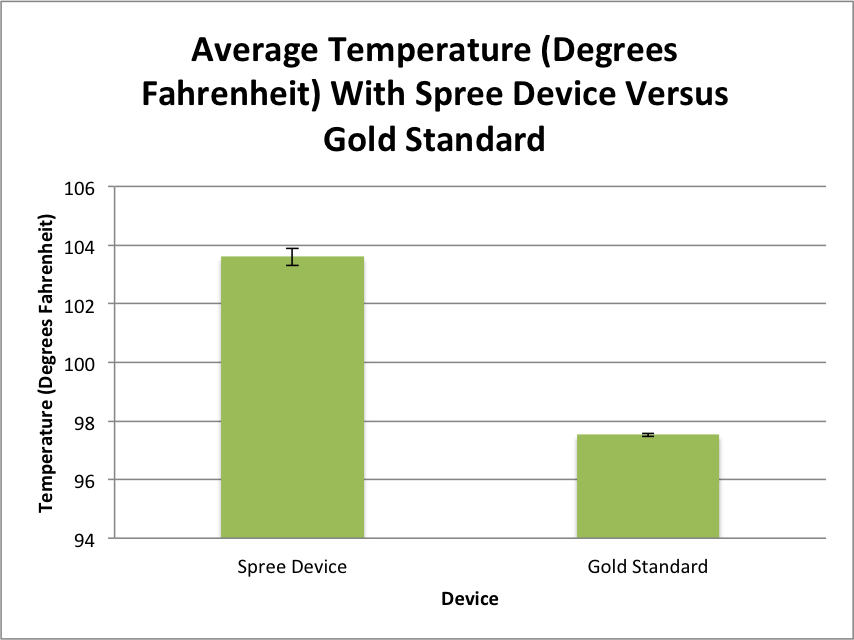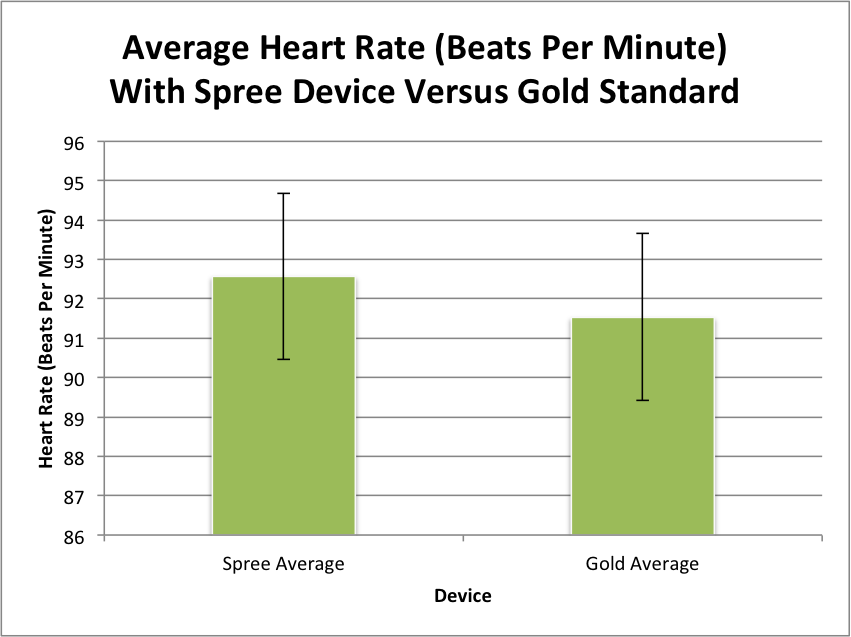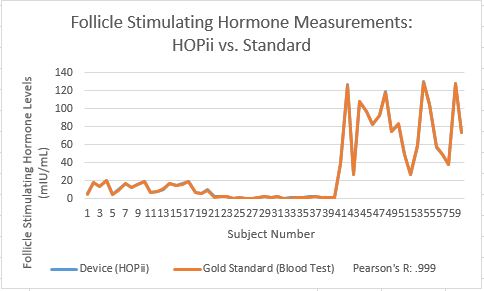BME100 f2014:Group14 L3
| Home People Lab Write-Up 1 | Lab Write-Up 2 | Lab Write-Up 3 Lab Write-Up 4 | Lab Write-Up 5 | Lab Write-Up 6 Course Logistics For Instructors Photos Wiki Editing Help | |||||||
|
OUR TEAM
LAB 3A WRITE-UPDescriptive StatisticsThe means of the temperatures from the gold standards and the Spree are essential in understand if the Spree device is effective or not. The mean of the temperature using the Spree (variable 1) was 103.6 degree fahrenheit and the mean using gold standards (variable 2) is 97.52 degree fahrenheit. The mean of the heart rates using the Spree was 92.57 beats per minute and the gold standards was 91.53 beats per minute. The standard deviation and the standard error are two important components of the statistics that will help enable users to understand the Spree.
Graphing
Inferential Statistics
Summary/DiscussionIn order to determine if the Spree is indeed an accurate replacement for traditional temperature and blood pressure measuring systems, we had to test and compare the product to a usual thermometer and pulse ox. When the two measurements are compared it can be concluded that the Spree provides an accurate reading of blood pressure but not temperature. Looking at the descriptive data for temperature, we can see that the average temperature for the Spree (103.6 degrees Fahrenheit) and thermometer (97.52 degrees Fahrenheit) vary by 6.08 degrees and show -0.00664, or no correlation. This information is further validated by the inferential data. The large difference between the critical t values and those found, show a significant amount of difference between the two devices. In regards to temperature, the Spree is not an appropriate substitute. The blood pressure reading between the Spree and pulse ox were very similar. The two means were 92.57 bpm (Spree) and 91.53 bpm (pulse ox), a difference of only 1.04. The Pearson's r value for this test was .98, an ideal positive correlation meaning the data was almost identical. According to the inferential statistics, the critical t value and the calculated t value very slightly, indicating that there is not a significant difference between the results of the two devices. The Spree provides a generally accurate reading for blood pressure. There was quite a bit of potential for error within this test. When taking averages, we did not take into account that the time intervals for the measurements differed; measurements were taken every two minutes during the two resting periods as opposed to every five minutes during activity. Moreover, not all the data readings were recorded for each group due to technical issues with the product. Another technical defect that may have caused error, is the placement of the Spree. Sweat from the forehead, or its constant contact with the sun could have skewed the readings. The timing for the temperature and blood pressure readings were off at times, with our group recording data a little earlier or later than the time specified. To improve the overall function of the Spree, the company should use actual temperature readings instead of giving a scaled 1-4 value. The placement of the Spree is also another flaw. Placing it near the core or abdominal part of the body would provide better temperature readings and avoid influence from external factors such as sunlight. Technological changes need to be made to ensure better bluetooth connection, as well as making it available to a greater population, not just iPhone users.
LAB 3B WRITE-UPTarget Population and NeedHormone Observation Patch Intermediary and Interface, or HOPII, targets women ages 13-65 who are having key hormone imbalances. Specifically women dealing with general hormone issues, who are pregnant, on birth control, going through menopause, puberty, thyroid problems or acne. The device will measure estrogen, progesterone, testosterone and follicle stimulating hormones. This monitoring device will be placed on the outer side of the upper arm and HOPII will measure the hormone levels every hour and record it for easy access by a doctor later. This monitoring device can be utilized for temporary or long term use, depending on the situation of the patient. Device DesignThis device contains a removable chip and replaceable patch that will be needed to be changed out everyday. Since blood testing is most accurate, there will be painless micro-needles underneath the patch that will go directly into the bloodstream of the patient. HOPII will also come with a phone application. With the Bluetooth feature enabled in the device, a patient will be able to see charts of normal hormone levels and compare to themselves any time of the day. In addition, if hormone levels are dangerously imbalanced, the application will alert the patient to make an appointment with their doctor as quickly as possible.
Dataset and StatisticsDataset To test the HOPii, we compared it to the results of a blood test. We used 60 test subjects: 20 women who have started their menstrual cycles, 20 pregnant women, and 20 post-menopausal women. The same 60 women were used to test the measurements of the hormones progesterone, estradiol, follicle-stimulating, and testosterone. We compared the results from blood tests to the average hormone reading given by the HOPii. We did this because the HOPii takes hourly readings while a blood test can only be administered, at most, once a day.
Progesterone: HOPii Average: 32.49933 Gold Standard Average: 31.99617 HOPii Standard Dev.: 60.49073 Gold Standard Stan. Dev.:58.69807 HOPii Stan. Error: 7.80932 Gold Standard Stan. Error: 7.577889
HOPii Average: 38.51667 Gold Standard Average: 38.21667 HOPii Standard Dev.: 17.3161 Gold Standard Standard Dev.: 17.34075 HOPii Stan. Error: 2.235498 Gold Standard Stan. Error: 2.238682
HOPii Average: 596.35 Gold Standard Average: 596.26 HOPii Standard Dev.: 938.0611 Gold Standard Standard Dev.: 938.0362 HOPii Stan. Error: 121.1032 Gold Standard Stan. Error: 121.1
HOPii Average: 30.905 Gold Standard Average: 30.8285 HOPii Standard Dev.: 39.48229 Gold Standard Standard Dev.: 39.4443 HOPii Stan. Error: 5.097142 Gold Standard Stan. Error: 5.092237
Graph
References"Follicle-stimulating Hormone (FSH) Blood Test: MedlinePlus Medical Encyclopedia." U.S National Library of Medicine. U.S. National Library of Medicine, 30 Sept. 2013. Web. 14 Oct. 2014. "Serum Estradiol Measurement." Lab Tests & Results. Medical University of South Carolina, 2014. Web. 15 Oct. 2014. "Serum Progesterone: MedlinePlus Medical Encyclopedia." U.S National Library of Medicine. U.S. National Library of Medicine, 25 Apr. 2013. Web. 15 Oct. 2014. "Testosterone: MedlinePlus Medical Encyclopedia." U.S National Library of Medicine. U.S. National Library of Medicine, 20 Feb. 2014. Web. 15 Oct. 2014.
|
|||||||























